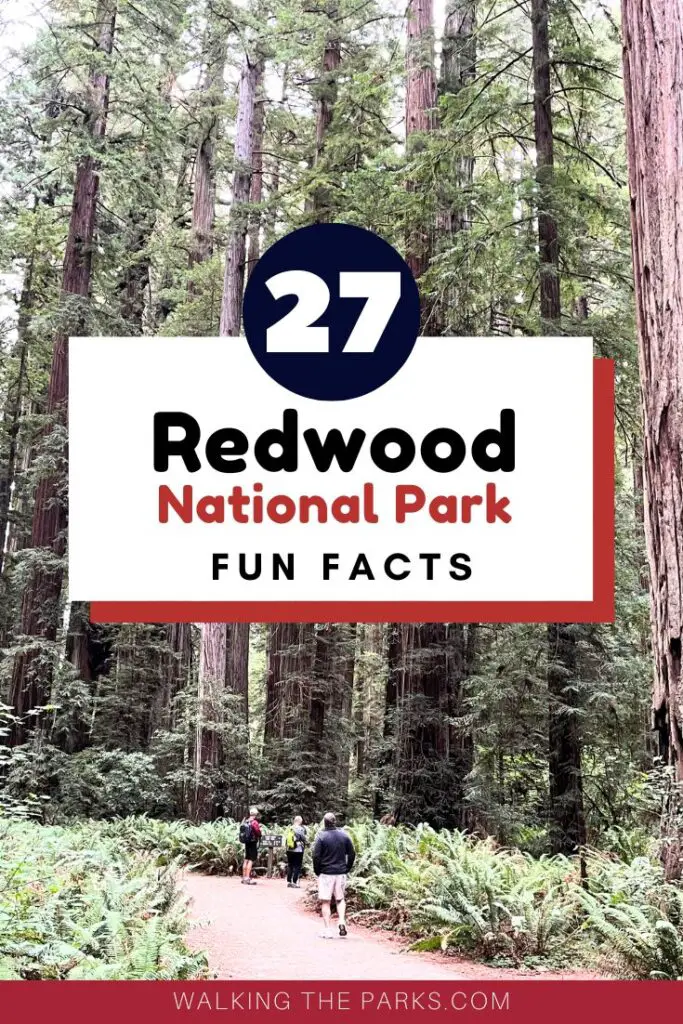From the towering heights of its ancient trees to the diverse ecosystems that thrive within its boundaries, Redwood National Park is a treasure trove of natural wonders. Here we’ve captured 27 facts about Redwood National Park.
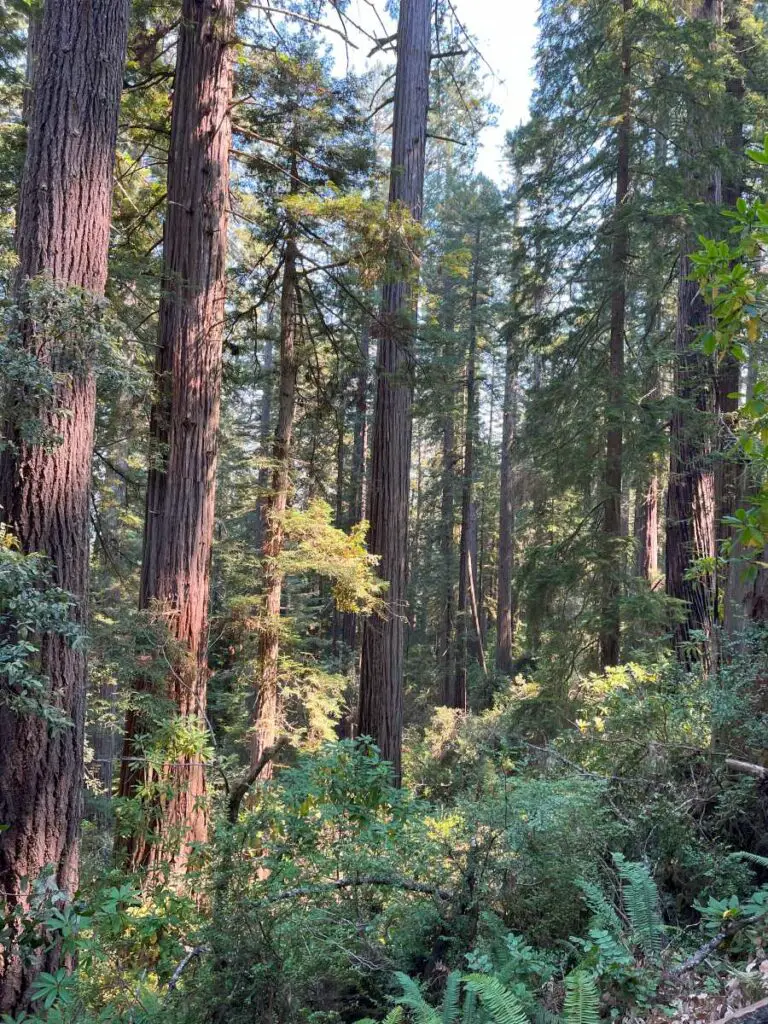
Redwood National Park quickly became one of my all-time favorite parks after our California National Park Road Trip. It is a unique National Park with a diverse ecosystem. Some facts on this list are just plain fun, other facts are important to know as you plan your Itinerary for Redwood National Park. So, let’s explore the fascinating secrets that Redwood National Park holds.
Quick Redwood National Park Facts
Location: Northern California near the Oregon border
Nearby Cities: Crescent City, 5.5 hours North of San Francisco
Size: 131,983 acres (206 square miles)
Annual Visitors: 460,000 (2022 NPS Stat)
Date Established: October 2, 1968
27 Interesting Redwood National Park Facts
On every trip through a National Park, Brad brings his science hat with him. His 35 years of teaching high school science made him the most inquisitive man I know. We ask a lot of questions as we explore. And Redwood National Park did not disappoint him. I learned so much on this trip and I know you’ll love these tidbits. Hopefully, as you plan your own trip this list will help you shape an amazing journey into a unique place.
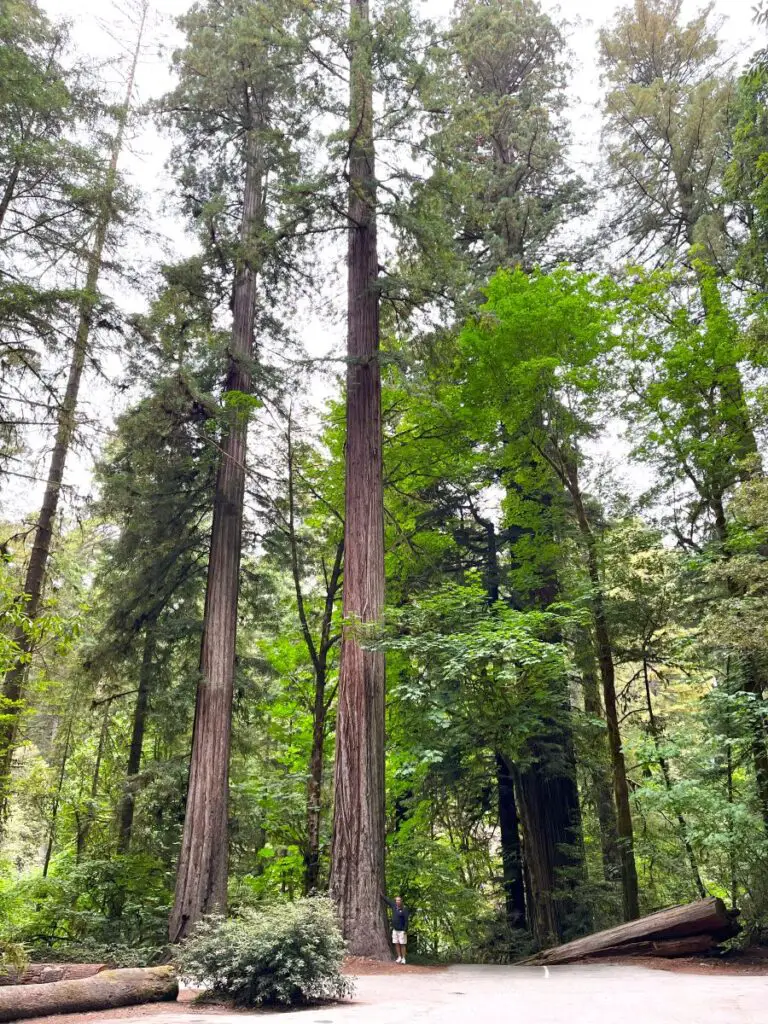
#1 Redwood National Park is home to some of the tallest trees on Earth, reaching heights of over 350 feet!
Redwood National Park is the land of gentle giants, where the trees reach for the clouds like nowhere else on Earth. Some of these coastal redwoods reach skyward over 350 feet. That’s taller than the Statue of Liberty from base to torch!
Take Hyperion which is not just a titan among trees but the reigning champ of height. This colossal natural wonder measures a staggering 379.7 feet. Then there’s Helios, a little shorter but no less impressive, stretching up to 374.3 feet. And let’s not forget about the massive Icarus, which soars to a lofty 371.2 feet.
During our trip to Redwood National Park, we couldn’t help but walk through these trees in awe and silence feeling the sheer scale of nature’s grandeur. Walking among them, you’re not just taking a stroll in a park; you’re wandering through a venerable forest of champions.
#2 In Redwood National Park, you will see trees that are over 2,000 years old!
Strolling through Redwood National Park is like stepping back in time, way back, over 2,000 years to be precise. That’s right, some of the majestic trees you’ll encounter have been around since the Romans were busy building their empire.
While you’ll encounter quite a few trees that have lived over 1,000 years the number that have reached 2,000 is quite small. The average age of the old-growth redwoods you’ll see in the park is between 500 and 700 years.
And fossil records show that relatives of today’s coast redwoods thrived in the Jurassic Era 160 million years ago. So if you imagine dinosaurs wandering through these forests as you walk through, you aren’t too far off from the truth.
Even at this great old age, the redwoods are not the oldest trees found in the United States. That honor goes to Bristlecone pines which are found in many parts of the western United States. We encountered these old ladies while traveling through Great Basin National Park. Some may be as old as 5,000 years.
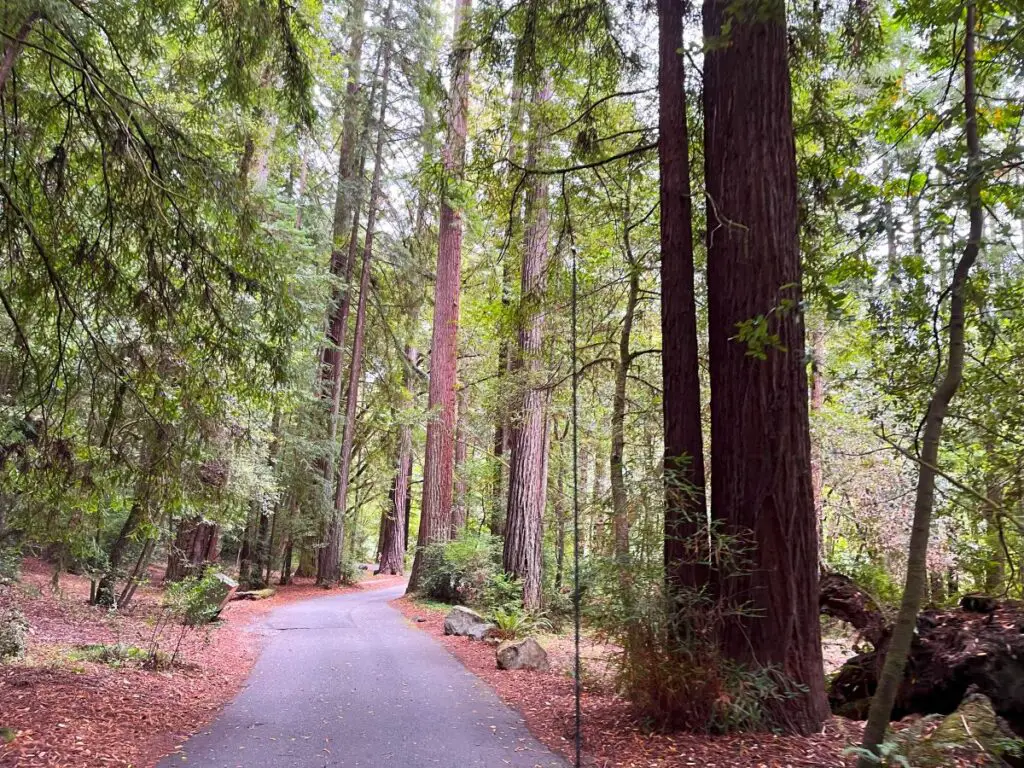
#3 There are 8 stunning scenic drives through the Redwoods
After driving dozens of National Park scenic drives, we unanimously voted that the drives through the Redwoods top the list. You won’t find a driving experience like this anywhere else. These first 3 were our favorites, with Howland Hill topping the list. Note that most of the scenic drives in Redwood National Park are rough roads and not suitable for RVs or trailers. The major exception to that is the Newton B Drury Scenic Parkway which is an easy road for any type of vehicle.
Top 3 Redwood Scenic Drives
- Howland Hill Road: Howland Hill Road is a narrow, unpaved road that offers an intimate encounter with the primeval redwood forest. It is rough and bumpy, and only a single lane in many places, making it unsuitable for trailers and RVs. However, we found the close-up view of some of the tallest trees in the world jaw-dropping. Along the way, the Stout Grove trailhead provides a convenient stop to stretch your legs and walk among the ancient giants.
- The Newton B. Drury Scenic Parkway: Nestled within the heart of Prairie Creek Redwoods State Park the Newton B. Drury Scenic Parkway is a paved 10-mile stretch of road that offers a serene alternative to the nearby Highway 101. It is named after a conservationist who was pivotal in protecting these ancient forests. Frequent pull-outs and trailheads along the way invite visitors to step out and walk among the trees.
- Bald Hills Road: Bald Hills Road is a winding road that ascends from the dense redwood groves up into the open and sun-drenched Bald Hills. The drive reveals expansive views of rolling grasslands, oak woodlands, and, in spring, a vibrant display of wildflowers. The road also provides access to several trailheads including the Lady Bird Johnson Grove and the Tall Trees Grove.
Other shorter scenic drives include
- Enderts Beach Road, where we encountered a small herd of elk and had a picnic at Crescent Beach.
- Requa Road takes you to a breathtaking view from the Klamath River Overlook.
- Coastal Drive (Loop) leads to views of the Pacific Ocean and Klamath River estuary where wildlife viewing is amazing.
- Cal-Barrel Road is a short 1.5-mile road through the old-growth redwoods. While it can be driven, it’s a great short trail for walking and a dog-friendly hike.
- Davison Road is a narrow winding road through the coastal redwoods that leads down to Gold Bluffs Beach and Fern Canyon. I held my breath on this one because of the tight curves! Note a permit is required for Davison Road throughout most of the season.
#4 Redwood trees are fire resistant
A fun fact about Redwood trees is that they have adapted to not only withstand fire but to use it as a tool for survival and regeneration.
Their bark is like a superhero suit. The bark is thick, fibrous, and contains tannins that make it resistant to fire damage. This means that when wildfires sweep through the forest, the redwoods can often emerge scarred but still standing strong. When the rings of a tree’s stump are studied, it’s common to see fire scars from hundreds of years ago.
But here’s where it gets even more interesting: fire plays a crucial role in the life cycle of a redwood forest. Low-intensity fires clear out the underbrush, which can otherwise choke young redwood saplings. Moreover, the heat from the fires can cause the redwood cones to open up and release their seeds. With the competing vegetation cleared away, these seeds find fertile ground to take root and grow.
For the redwoods of Redwood National Park, a fire is a beginning, a vital part of their enduring legacy.
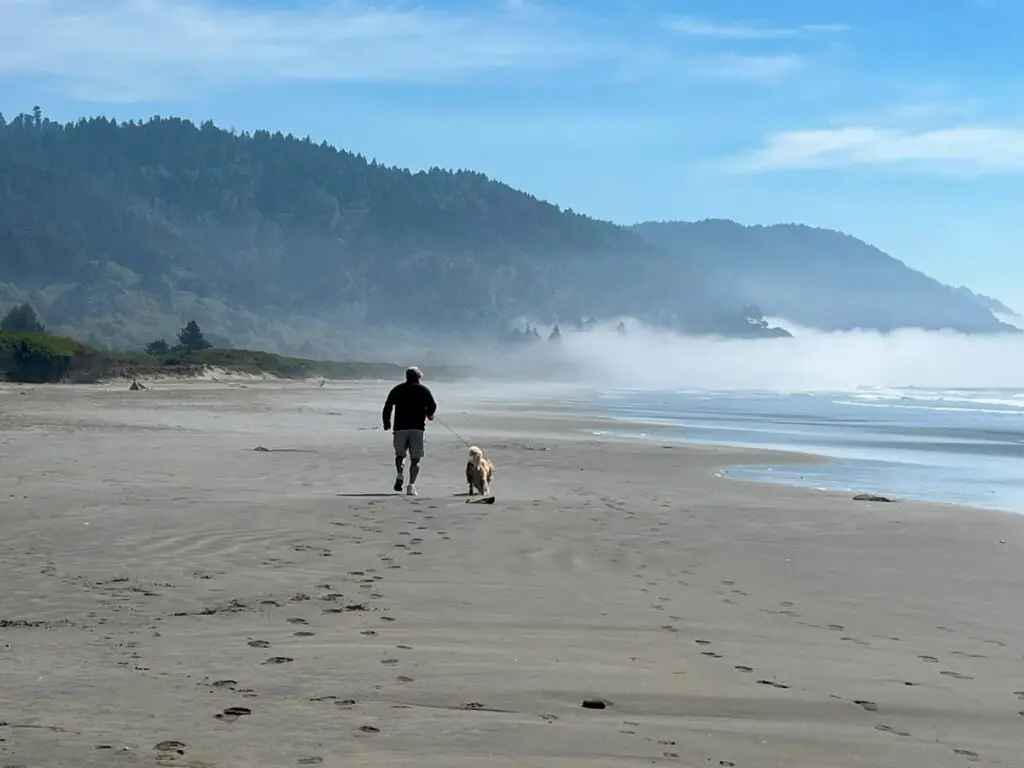
#5 Redwood National Park includes 40 miles of California’s Northern Coast
With all those giant trees, the ocean and coastline might not be on your mind when you think about Redwood National Park. But this park protects over 40 miles along the Pacific Ocean. This stretch is peppered with sandy beaches and sheer cliffs, featuring tide pools teeming with marine life at its base.
#6 Redwood trees can grow in a circle around the remains of an old tree, creating a unique formation called a “fairy ring.”
There are many tales about magic causing the redwood tree’s fairy ring. But in fact, there’s a very scientific reason why young redwoods grow in a circle around an old dying tree.
The big surprise is that it’s not the tiny seeds of a redwood cone that are responsible for the propagation of the species. Instead, it is the redwoods’ ability to sprout new trees from their roots.
These sprouts emerge from the roots of an old tree in a circular pattern around the parent tree. As new trees grow from the roots of a dying parent tree they form a circle, aptly named a fairy ring, which is nurtured and sustained by the parent’s roots. Over time, the central trunk of the parent tree may decay leaving behind a picturesque ring of redwoods.
#7 Logging has destroyed 96% of the original old-growth coast redwoods
A Redwood National Park fact that is as shocking as it is sobering, a staggering 96 percent of the original old-growth coast redwoods have been logged.
These ancient giants faced a drastic decline due to extensive logging practices starting in the 1850s during California’s Gold Rush and continuing into the 20th century. The redwoods once covered more than two million acres along the coast. They were sought after for their remarkable wood which is prized for its beauty and resistance to rot.
The loss of these old-growth forests is not just about the trees themselves but also the unique ecosystems they support. Old-growth redwoods are home to many species that rely on the complex habitats these towering trees provide. Conservation efforts have turned the tide, with places like Redwood National Park acting as sanctuaries for old-growth redwoods.
#8 Over a dozen common invertebrates can be seen in tide pools at low tide
The park’s coastline is home to amazing tide pools filled with dozens of colorful sea creatures like sea stars, anemones, and crabs. It’s like exploring your own underwater wonderland!
First, do you know what a tide pool is? It’s a depression, often only a few feet wide, where seawater is trapped when the tide goes out. The pool is surrounded by and contains a variety of rocks that sea creatures cling to as a way to stay safe from harsh waves. When the tide comes in, these invertebrates are deep in the water. And when the tide goes out, the creatures living in the pool are exposed to the sun, hungry birds and tourists like us.
Tide pools are usually in hard-to-access places, like the base of tall cliffs. Endert’s Beach, inside the parks’ boundaries, is a great place to explore tidepools. However, you must stay aware of the timing of low tide so you don’t get caught in rising waters. And make sure you have sturdy shoes to walk over the moss covered rocks.
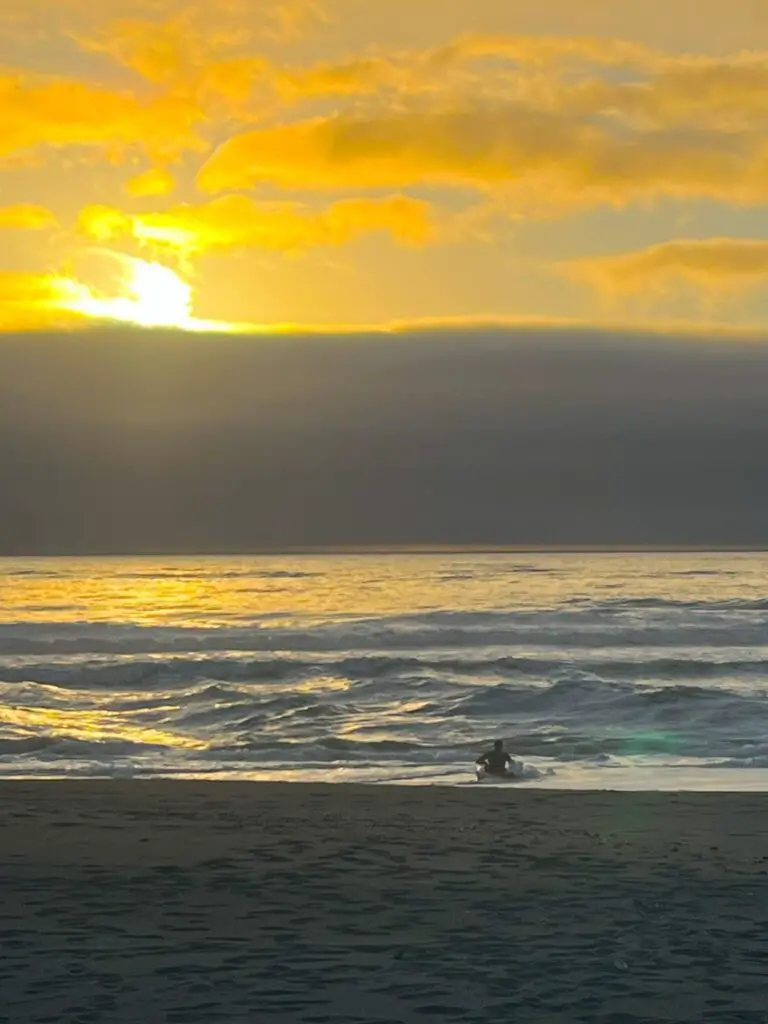
#9 The average ocean water temperature at the beaches is 55 degrees
While Redwood National Park has some gorgeous beaches, you won’t find many bikinis here. The warmest month is August when water temperatures might hit the high 50s. And there’s quite a cooling breeze along the coast. We enjoyed our beach day in a sweatshirt.
What you will find on the beaches are miles of sand dunes. The beaches are teaming with wildlife from huge Roosevelt Elk to small sand dollars. And the sunsets are gorgeous.
The most famous beach is Gold Bluffs Beach, which requires a permit to enter most of the year. We camped on this beach and it is now on my list of top 10 favorite campgrounds. Enderts Beach and Crescent Beach Overlook are also two popular places to enjoy an amazing view of the Pacific Ocean.
#10 The park’s coastal waters are home to diverse marine life
Redwood National Park’s coastal waters serve as a haven for a variety of marine creatures, including seals, sea lions, otters, and migrating gray whales.
We loved watching, from the shore of Gold Bluff Beach, a seal bobbing in the surf. Seals and California sea lions can often be seen lounging on coastal rocks in Redwood National Park. Another marine mammal frequently observed in the park’s coastal waters is the sea otter.
Perhaps one of the most awe-inspiring visitors to the park’s coastal waters is the migrating gray whale. These leviathans travel up to 12,000 miles round-trip between their feeding grounds in the Arctic and their breeding lagoons off the coast of Baja California, Mexico. The park’s coastline provides a prime vantage point for whale watching during the peak migration seasons in the late winter and early spring.
#11 The park is a haven for birdwatchers, with over 280 species of birds recorded here
Redwood National Park is a paradise for bird enthusiasts. The park’s varied habitats host a rich birdlife.
- The towering redwoods provide an ideal habitat for species such as the Marbled Murrelet, a secretive bird that nests in the high branches of old-growth trees. The forest floor below is alive with the melodies of Pacific Wrens and the vibrant flashes of Varied Thrushes.
- Along the park’s waterways, one might spot the American Dipper bobbing in and out of the stream, while raptors like the Osprey and Bald Eagle soar overhead, scanning for their next meal.
- The park’s coastal interface adds another layer to its avian diversity. The offshore rocks and nearby beaches are frequented by Black Oystercatchers, Pigeon Guillemots, and a variety of gull species. During migration seasons, the skies and shores become a bustling corridor for shorebirds and waterfowl, making Redwood National Park a critical stopover point on the Pacific Flyway.
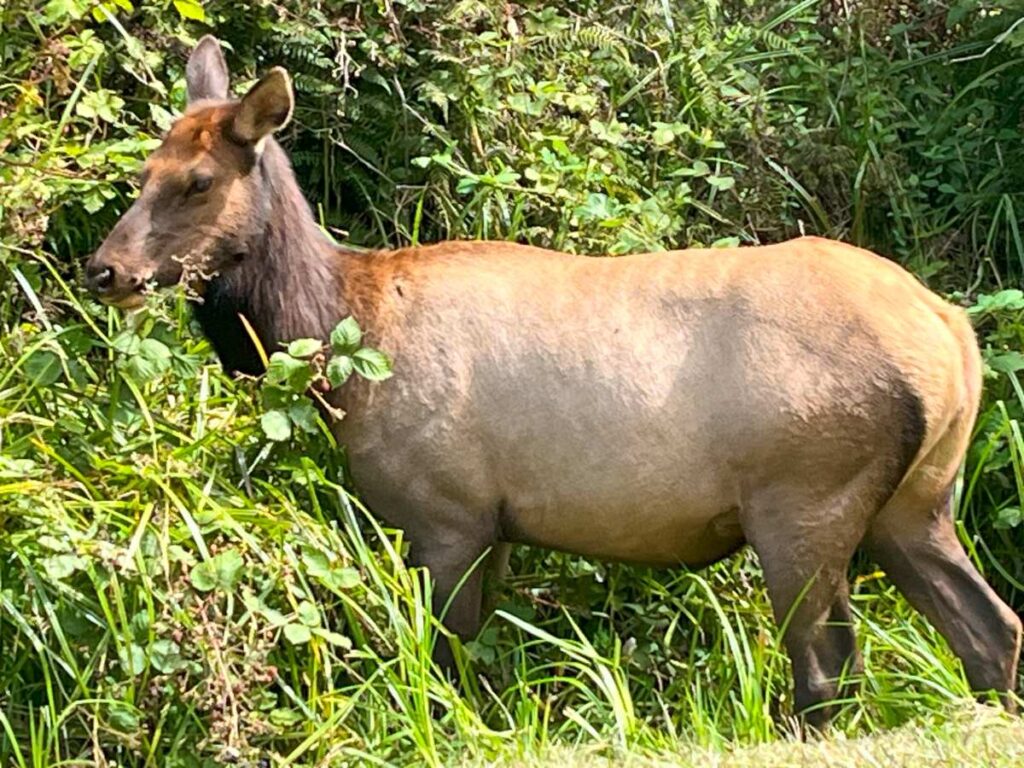
#12 Roosevelt elk (Cervus elaphus roosevelti) is the largest subspecies of North American elk
A century ago, the future of the Roosevelt elk in this region was unlikely. Unregulated hunting and habitat loss had reduced the local herd to 15 elk. Today, due to conservationism, the elk population is healthy and they are one of the most commonly seen animals in Redwood National Park.
While elk can be seen almost anywhere in the park, many visitors enjoy relaxing near Elk Meadow just outside Prairie Creek Visitor Center. In the early evening, a local herd often comes out to graze. Bald Hills Road is another common area for elk sightings. We saw another small group of female elk just off Highway 101 on the way to Crescent Beach.
The Roosevelt elk have impressive antlers that can span up to six feet. And a male (bull) can weigh up to 1200 pounds. They can be aggressive when they feel threatened so keep your distance. Bring your binoculars so you can get a close-up look at these majestic creatures when you visit the redwoods.
#13 California Condors were re-introduced to Redwood National Park in 2022
In a landmark conservation effort to save endangered species, the skies of Redwood National Park witnessed the return of the California Condor in 2022.
The California Condor, North America’s largest land bird with a wingspan stretching up to 9.5 feet, is a symbol of wildlife conservation. By the mid-20th century, the nearly extinct condor was only found in zoos. Their numbers had dwindled drastically due to poaching, lead poisoning, and habitat destruction.
The reintroduction in Redwood National Park is part of ongoing efforts to re-establish the California Condor in its historic range. The park provides an ideal habitat, offering the condors a chance to thrive.
Their return is not only a significant boost to biodiversity but also an inspiring success story of conservation and collaboration. Wildlife biologists from the Yoruk Tribe led the program in association with the National Park Service, US Fish and Wildlife Service, National Park Foundation, Peregrine Fund, Ventana Wildlife Society, PG&E, California Redwood State Parks, and many other conservation groups.
#14 The Giant Sequoia, Sequoia National Park, is bigger by volume than the Coastal Redwoods
While the Redwood trees of Northern California hold the trophy for being the tallest trees, their nearby cousins, the Giant Sequoia (sequoiadendron giganteum) are bigger by total volume. The Sequoia tree is much fatter at the base sporting an immense trunk. Redwoods are only found at low elevations while Sequoia trees only grow between 4,000 and 8,000 feet along the western slopes of the Sierra Nevada. Sequoia are found in protected groves in Sequoia National Park and Yosemite National Park.
These towering trees share many characteristics. Both species share a strong resistance to fire. And both giants have diminutive cones with the redwood cone about an inch long and the sequoia cone about 2.5 inches long.
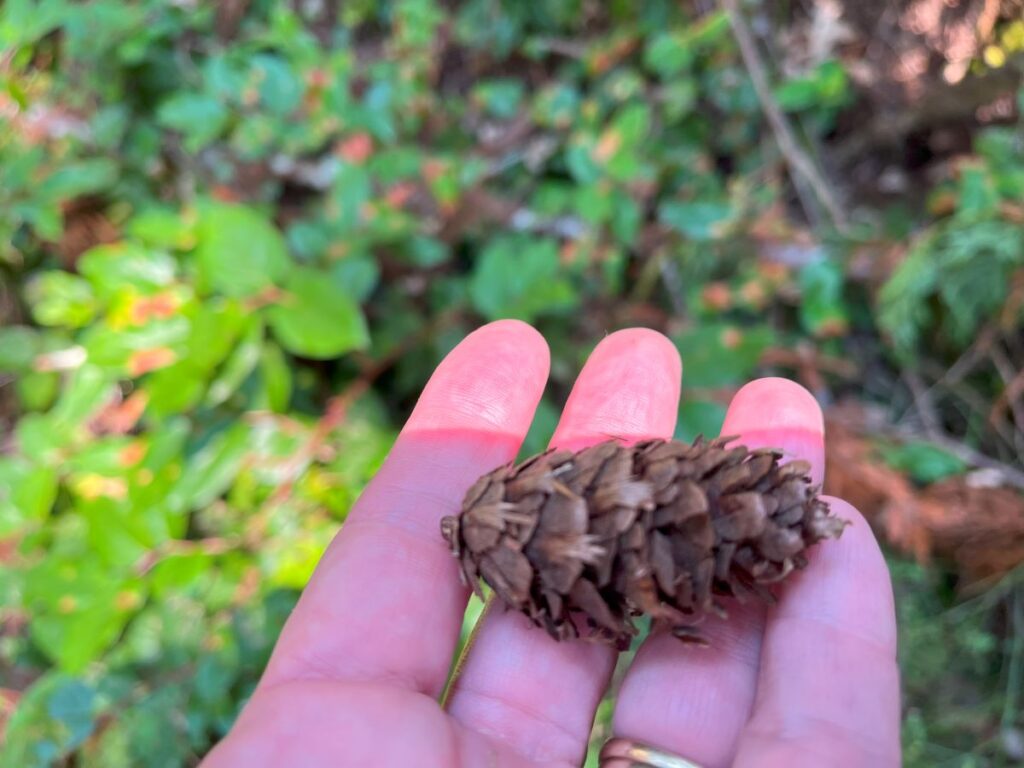
#15 The cone of the giant redwoods is only 1 inch long
When you think of the colossal redwoods towering over Redwood National Park, you might expect every aspect of these trees to be supersized. But nature throws us a delightful curveball with the redwoods’ pinecones. These giants produce cones that are unexpectedly petite, averaging just about 1 inch in length!
It’s a fun fact that took us by surprise as we walked among the ancient forest. This modest size doesn’t hinder their effectiveness, though. Each little cone is packed with seeds, ready to be scattered by the wind or foraging animals. So, as you explore the wonders of Redwood National Park, keep an eye out for these little cones.
#16 There are over 200 Miles of Maintained Hiking Trails
More than 200 miles of trails weave through a variety of environments; including prairies, old-growth redwood forests, and beaches. Elevations range from sea level to just over 3,000 feet (1,000 m).
Consistently mild temperatures make year-round exploration a possibility. The parks’ trails are well maintained – though weather conditions may make the trails slippery. Few trails are paved.
#17 The California Coast Trail runs through Redwood National Park for 70 miles
Encompassing 70 miles within the park’s boundaries, the California Coast Trail is part of a larger public trail system. The CTA spans 1,200 miles from Oregon to Mexico, along the California coastline.
You can enjoy the beauty and wonder of the California Coastal Trail while visiting Redwood National Park. You’ll find 5 trailheads in the park where you can enjoy a 3 to 6 mile day hike along the ocean. Or get a backcountry permit so you can camp along the trail, extending your adventure.
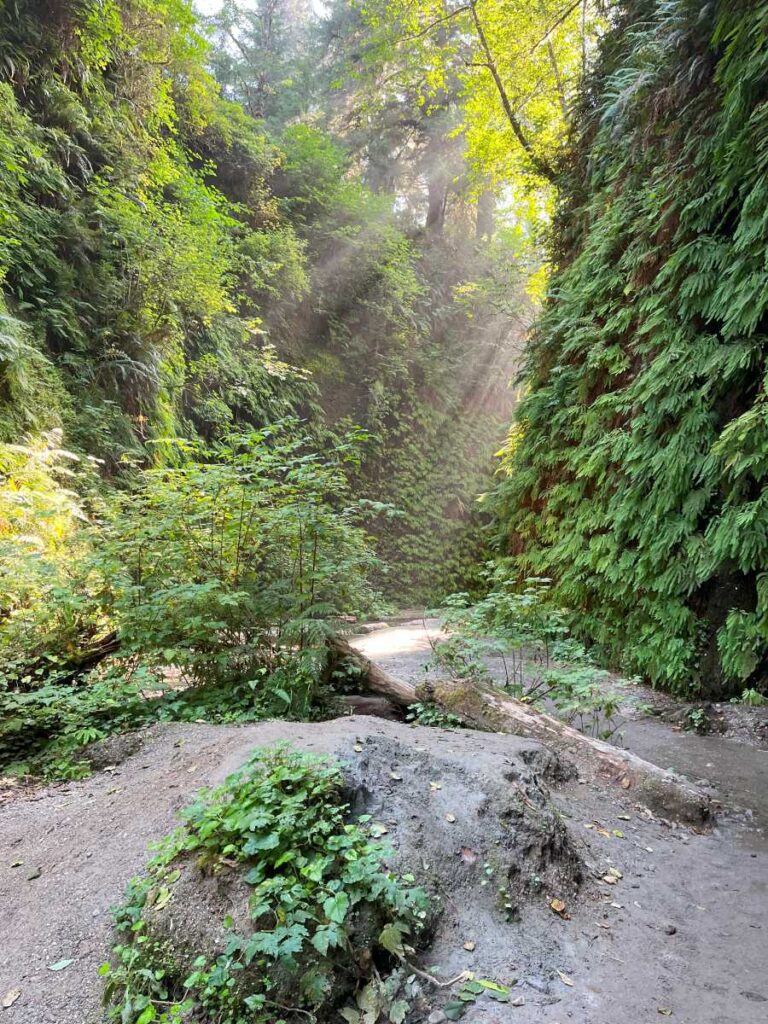
#18 Hiking to Fern Canyon is like stepping into a prehistoric world!
This lush gorge is covered in ferns and mosses, and it even served as a filming location for a scene in Jurassic Park 2: The Lost World.
Fern Canyon is accessible at the end of the scenic Davison Road which is a short walk from Gold Beach. Or you can take the longer hike (9 miles round trip) on James Irvine Trail, which trailheads on The Newton B. Drury Scenic Parkway.
We highly recommend that you visit Fern Canyon because it was one of our favorite stops. For us, it was like stepping into a fairyland.
#19 Did you know that coast redwoods, the trees found in the park, can absorb water through their leaves?
That’s right! A great scientific Redwood fact is they can “drink” water directly from the air, which makes the foggy coastal climate a perfect home. A large redwood can drink up to 53 liters (14 gallons) of water per hour through its leaves.
A redwood has two different types of leaves. Most of the leaves are for photosynthesis, they use the sun to create energy for the tree to grow and survive. However, about 10% of the leaves pull in moisture from the air, primarily from the coastal fog. Since it’s a long distance for water to move from the roots of a redwood to the top leaves, this leaf-drinking adaptation helps the trees supply critical water to the top.
#20 The park’s history includes indigenous tribes such as the Yurok, Tolowa, and Karuk
Long before the establishment of Redwood National Park, the indigenous tribes, notably the Yurok people, thrived in harmony with the towering redwoods of northern California. They held these majestic trees in deep reverence, integrating them into their daily lives and spiritual beliefs.
The Yurok, along with other native American tribes, ingeniously utilized the redwoods for building their homes, crafting canoes, and creating tools essential for their survival. They gathered amidst these ancient forests for ceremonies and relied on the rich biodiversity therein for sustenance. These practices underscored a profound connection to the land, emphasizing respect, coexistence, and sustainability.
#21 The Spanish first explored the redwoods in the late 1700s
In the late 16th and early 17th centuries, European explorers began to navigate the Pacific Coast. They were driven by the allure of new lands and the promise of wealth. Among these were the Spanish, who charted much of the California coastline.
The dense redwood forest, with its rugged terrain and thick underbrush, proved to be a challenging barrier to these early explorers. The sheer size of the redwoods were unlike anything the Spanish had encountered before, and the trees quickly became a symbol of the untamed beauty of the New World. These early encounters would pave the way for future exploration and eventual settlement, but the redwoods themselves remained largely undisturbed.
While the Spanish explorers did not leave a significant mark on the redwood forests, their voyages contributed to the broader mapping and understanding of the Pacific Coast.
#22 Jedediah Smith created the first written documentation of Redwood National Park in 1828
In the spring of 1828, Jedediah Smith embarked on an expedition that would lead him through the uncharted wilderness of the coastal redwoods. Smith was a trailblazer, hunter, and fur trapper. He played a pivotal role in exploring and mapping the American frontier.
Smith and his party of about 20 men are the first recorded non-Native Americans to travel overland north from California, through the towering redwood forest, to Oregon Country. Smith’s expedition provided some of the earliest written accounts of the interior of what is now the Redwood National and State Parks.
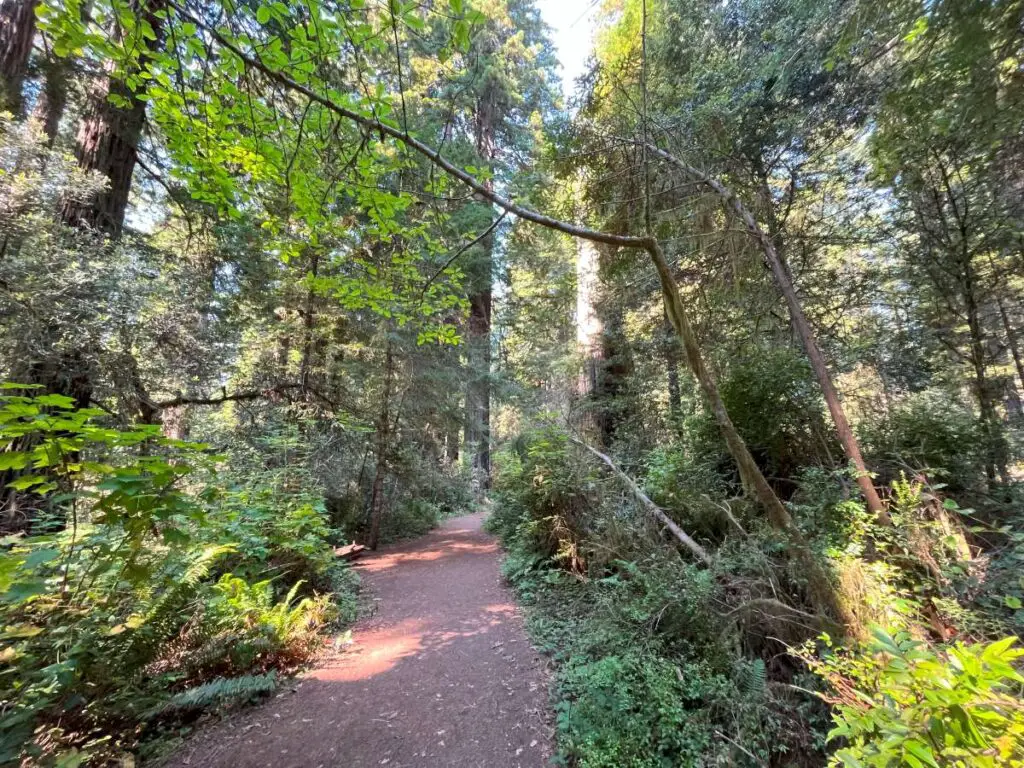
#23 Lady Bird Johnson was influential in establishing Redwood National Park
Lady Bird Johnson, former First Lady of the United States during the presidency of Lyndon B. Johnson, had a profound impact on the conservation efforts and expansion of Redwood National Park.
In 1968, her influence was pivotal in the establishment of Redwood National Park, which was signed into law by President Johnson. Recognizing the urgent need to protect the remaining old-growth redwood forests from the threat of extensive logging, Lady Bird Johnson’s advocacy helped to secure the federal protection of these towering trees for future generations.
In honor of her contributions, a grove of redwoods within the park was dedicated to Lady Bird Johnson in 1969. The Lady Bird Johnson Grove sits atop a ridge and can be reached from Bald Hills Road.
#24 Three major movies have been filmed in Redwood National Park
It’s a fact about Redwood National Park that this natural gem has also starred on the silver screen in three popular movies:
- Star Wars: Return of the Jedi
- Jurassic Park: The Lost World
- E.T.: The Extra-Terrestrial
Directors chose this location for its unmatched, untamed landscapes. As you walk through the park you’ll understand how easy it is for this unique National Park to transport viewers to another time.
This attention brought a surge in park visitation. Movie-goers yearned to step into scenes they had only experienced through their screens. While I like to think we aren’t easily sucked into Hollywood hype, we found walking through Fern Canyon a little more exciting as we imagined the dinosaurs of Jurassic Park tromping through the ferns.
Hollywood’s spotlight on Redwood National Park showcased the sheer magnitude and beauty of these ancient forests, helping to elevate public appreciation and awareness.
#25 There are 4 Campgrounds and 317 Campsites in Redwood National and State Parks
There are four campgrounds in Redwood National and State Parks.
- Jedediah Smith
- Prairie Creek
- Gold Bluffs Beach
- Mill Creek
Over 300 campsites provide some of the most unique National Park camping nights we’ve experienced. We spent one night sleeping with the giant redwoods as our canopy. And the next night on the beach of Gold Bluffs listening to the waves crash.
Make sure you get reservations in advance. All 4 campgrounds are managed by the California State Parks.
#26 Redwood National and State Parks are a unique partnership between California and the US Government
In the 1920s, citizens and the state of California began buying land to preserve some of the redwood groves. Parts of these purchases are now thre state parks that are located here.
- Del Norte Coast Redwoods State Park
- Prairie Creek Redwoods State Park
- Jedediah Smith Redwoods State Park
In the late 1960s, the federal government purchased from timber companies some of the last sections of old-growth redwood groves and this became the Redwood National Park. As you can see on the park map, the National Park borders and surrounds most of the State Park areas. In 1994 the management and operations were combined. State park employees work alongside national park employees, and as a visitor, you might not even notice the difference.
#27 Winter is the rainy season with 60 to 140 inches of rain each year
Each year, the park is drenched with an impressive 60 to 140 inches of rain, transforming the landscape into a lush, green wonderland.
The rain begins to fall heavily in late fall and continues through the winter months, peaking in intensity between November and March. During this time, the park’s streams and rivers swell with the influx of water. This substantial rainfall is essential for the survival of the park’s iconic coast redwoods (Sequoia sempervirens). Their shallow root systems extend widely to capture as much surface water as possible.
If you visit Redwood National Park during the rainy season, you will be treated to a unique experience. Mist often shrouds the towering redwoods, creating an ethereal atmosphere that feels like you’ve stepped into another world. The rain enhances the scent of the forest, releasing rich, earthy aromas that are both refreshing and invigorating.
While the wet conditions might deter some, those who grab a rain jacket and venture into the park during winter are rewarded with fewer crowds. Waterfalls that are dormant during the dry months come roaring to life. And the saturated colors of the mosses and lichens that drape the trees are at their peak.
A few last thoughts about Redwood National Park
As we conclude our journey through the awe-inspiring Redwood National Park, it’s clear that this natural wonder offers an abundance of unique, fun, and interesting facts. The park is a testament to the enduring beauty and complexity of the natural world.
The 27 facts about Redwood National Park we shared are but a glimpse into the rich tapestry that makes Redwood National Park an exhilarating discovery. There’s always more to learn and love about this cherished landscape.
We hope that the enchantment of these towering giants and the stories they hold inspire you to visit and create your own memories among the redwoods. Remember, each visit contributes to the ongoing conservation efforts that ensure future generations can also experience the magic of these forests. So, pack your sense of adventure and let the timeless majesty of Redwood National Park move you.
